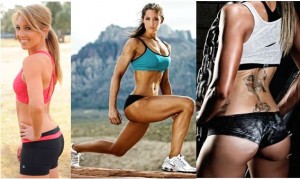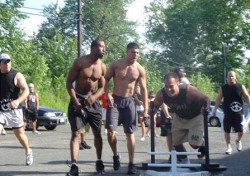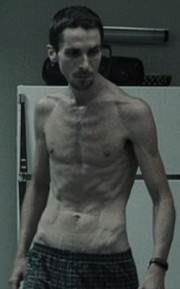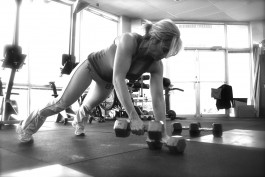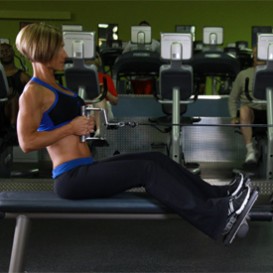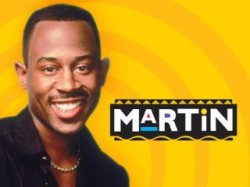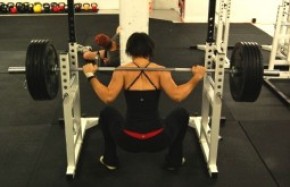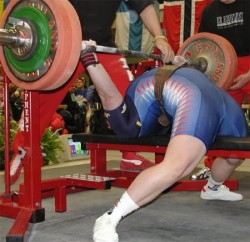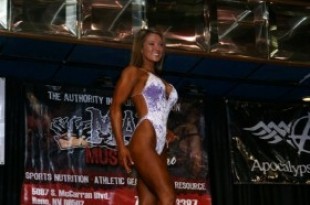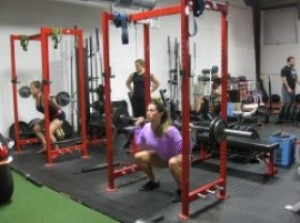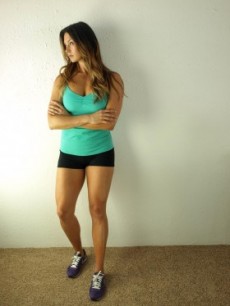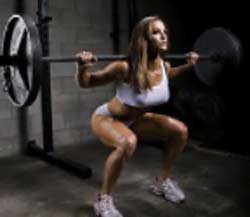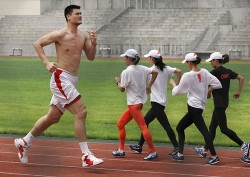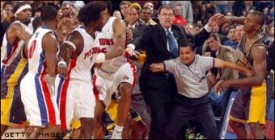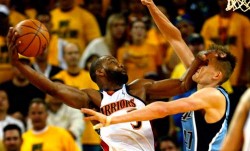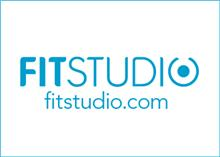Nothing Beats In The Trenches Experience!
November 29, 2011 by danny · Leave a Comment
In the fitness world, science can be very beneficial. Science has helped advance the field and will continue to do so in the years to come. However, it is not without its limitations. The results obtained by researchers may give them X, Y, or Z results – in the setting that the research was conducted. However, not every study ever performed was designed to meet your particular needs in your exact situation.
Another thing about research/science; there is still a ton to be tested. We’ve all formed an opinion based on what we’ve observed with our training and nutrition (and/or while working with our clients). And we didn’t have to wait for a study to be conducted to form this opinion. This is where “in the trenches” experience sometimes trumps science.
With that said, I contacted a handful of Coaches that have logged thousands of hours working with their own guinea pigs. This in the trenches experience has left each of them with training and nutrition information that you just won’t find from the white coats.
Danny: Nate, when it comes to nutrition, what is the biggest mistake that you see from most trainees that are trying to add muscle?
Nate: “I think the biggest mistake is the low-carb trend. Research has shown that for the obese, sedentary, and insulin resistant/type II diabetic populations, low-carb plans are the most effective approach. These populations should follow a Paleo-style plan 100%.
The active, anaerobic athlete whose primary goal is physique enhancement should add back in a select few, low fructose, non-”anti-nutrient” containing carbohydrates to support their training and recovery demands. Recommendations include potatoes, rice, and yams/sweet potatoes.
Still most modern foods like sugar, dairy, bread, juices, and whole grains (as are typical in many physique athletes’ plans) remain off-limits to avoid the host of metabolic, hormonal, and digestive diseases associated with modern eating.”
Danny: Bret, what is THE biggest mistake individuals make when trying to improve their glutes?
Bret: “This one is easy! The biggest problem is that they’re not activating their glutes sufficiently. The gluteus maximus is a strange muscle. It’s always trying to find a reason to shut down and go to sleep. Any lower body injury or pain will shut it down, any activity that’s easy will not activate it sufficiently, and quite often people are performing great glute exercises but aren’t activating them properly throughout the movements. For example, you can squat and lunge while using mostly quad and erector, and you can deadlift and bridge by using mostly erector and hammy. When people learn to activate their glutes properly and master the feel of strong glute contractions, they’ll begin to heavily incorporate their glutes into all of their lower body movement patterns, including squats, deadlifts, good mornings, lunges, hip thrusts, back extensions, and even planks.
Many readers have seen all of my Youtube videos of strong girls and athletes moving heavy weight on their glute exercises, but they don’t start out that way. Most of my clients start out with bodyweight squatting and bridging and I have to work hard to get them to sit back, keep their knees tracking over their toes, utilize proper lumbopelvic mechanics, push through the feet properly, and symmetrically activate the glutes. Once all of these are happening, then I add load. After around six weeks clients almost always boast about how well their glutes work during their sessions.”
Danny: Tim, what is THE biggest training mistake made by the “intermediate” lifter that is trying to add muscle?
Tim: “I would say the biggest mistake an intermediate lifter makes (excluding simply not training hard, because if you aren’t doing that it doesn’t matter what soviet bloc routine you are on) is that they get decent results with one method and they just stick with it too long. They become HIT guys or Westside Guys or DC guys or Kettlebell guys or whatever. To build muscle to you want to stimulate the muscle as much as possible in a variety of ways. You want to do some serious strength training but don’t focus exclusively on that. You should try some higher rep stuff but don’t focus exclusively on that. And a good chunk of time should be spent on the intermediate modalities. A simple guideline is train 25% of the time for strength (high weight, low reps), to train 25% of the time for endurance (lower weight, higher reps – as in 20 or so), and to train about 50% of the time in the traditional size building zone (moderate weight, moderate reps, high volume). Personally I had good success following a HIT routine for 6 weeks (1 all out set on the exercises), a Westside routine for 8-10 weeks, and then a more classic traditional bodybuilding routine for 6-10 weeks and then just rotating through them again. Do several rounds of that and you will be bigger and stronger no doubt about it.
I would also add that a close second mistake is that the intermediate level lifters should start to understand their bodies and start to figure out what works and what doesn’t. Tricep pushdowns might give you big triceps or they might not. Same with dips and close-grip bench press. Don’t just perform an exercise forever because some expert said it would do something for you, give it a fair test (2-4 months) and see what happens. If you don’t get any measurable results from that exercise, drop it and try something else.
Finally try to surround yourself with like-minded individuals that have similar goals and train their ass off. Don’t underestimate the power of training in a productive environment with strong social support. The “me against the world” mentality is nice for a while but it gets old real quick and you only have so much energy, better to use that energy to create a good environment then always fight a bad one.”
Next I contacted this really good-looking guy, Danny McLarty. Since I’m used to talking to myself, the conversation went really smooth!
Danny: What do you find is the biggest mistake made by trainees trying to take their physique to the “next level?”
Danny: “In my mind, there is no doubt the biggest mistake that most people make, is that fact that they change their goals far too often. We all want to have the strength of an NFL linebacker, while having 2.4 percent body fat, while training to knock out GSP, while having so much muscle that we make the average human being look like Christian Bale in the Machinist.
But that just ain’t happenin’. Pick a goal and STAY WITH IT long enough to see it come to fruition. As the great Dan John says, ‘the goal is to keep the goal the goal.’
Don’t go try to get as HYOOGE as possible one week, only to decide it’s time to get shredded the next. Pick one goal, focus all your efforts on this goal, and kick some ass while you are at it!”
Danny: What is the biggest nutrition mistake made by the individual trying to lose fat?
Dr. Clay: “From what I’ve seen, by FAR what holds most well-intentioned dieters back is failing to adhere to a very specific plan. People tend to do things like “eat well” or “eat less carbs” and so on. But if you ask them “how many grams of carbs are you eating?” they don’t know exactly.
One must first have a specific plan. For example, “have 150 grams of carbs on days I lift weights.” Then to make sure that actually happens, write down EXACTLY how many carbs you consume. After a couple weeks, you’ll know if that’s gonna work or not and you can tweak from there. (Of course the same goes for protein and fat.)”
Science is great, and I know it has influenced each one of us involved in this Q and A. But NOTHING is more helpful than experience training people in real live situations. Many people say that knowledge is power. I disagree – knowledge is information, applied knowledge is power. In this article, you have information that you can APPLY right away. Do so and go take your physique to the next level!
If you have any tips that you have found to be particular beneficial in your training/nutrition plans, let us hear them in the comments section below.
If you’re on twitter, you can find me @DannyMcLarty
Kids and Weight Training
November 23, 2011 by danny · 5 Comments
When should my child begin weight training? I get this question from parents all the time. My answer to the question has more to do with mental maturity than it does physical maturity. In other words (with the proper supervision and coaching), from a physical maturity standpoint, I do NOT think an 8 or 9 year old is too young to start weight training. Legend Mel Siff, in his book, Facts & Fallacies in Fitness states that, “stresses imposed on the body by common sporting activities such as running, jumping and hitting generally are far larger (by as much as 300%) than those imposed by Powerlifting or Olympic Lifting.”
Running up and down the basketball court, soccer field, baseball field, or jumping off of the monkey bars at recess is WAAAY harder on the body than lifting weights!
And then you add to the fact that the goal of weight lifting for kids is not to test his or her 1 RM (Rep Max). If set up properly, the coach/trainer will start kids off in the weight room with the goal of “building a foundation,” to teach them proper form. When the kid reaches high school, (s)he will be well equipped to start adding weight to the bar. When I work with kids, my goal is to improve their movement quality, teach proper form, and help make it fun for them so they develop a passion for working out the rest of their life.
Movement Quality – Over the years this has gotten worse and worse with today’s youth. They spend too much time sitting on their rears. The increase in video games and tv has contributed to kids moving poorly.
Form/Technique/Cues – When kids get to hear cues from the coach like, “tuck your elbows” while doing push-ups, or, “drive through your heels,” when doing lunges, it sets them up for success when it comes time to add some weight to the bar.
Machines Are Safer Than Free Weight For Kids
Some people believe machines to be safer for kids than free weights (your own body weight, barbells, and dumbbells) due to the static nature (and fixed position) of machines. I do NOT believe this to be true. To me, this would be like giving kids a calculator in first grade and telling them to just “use this and don’t worry about learning to add and subtract.” In sports (and in life), kids need to learn how to control their bodies through space. Dynamic warm-ups and free weight/body weight exercises are great to help youngsters prepare for “real world” activities.
Mental Maturity
As I mentioned above, this is what truly tells us when a kid is ready to start weight training. I’ve had parents send their young kids to me, and while I’m explaining what we are about to go over, they are more interested in following the butterfly floating around outside the window. I can just “feel” that the ONLY reason the kid is in the gym training with me, is because mom or dad made him/her go. If this is the case, I suggest to the parents that at this time, they should simply encourage their kids to be active… go out and play catch with them; take them to the pool to swim; play tag with friends; go to the park and have them run around the playground, etc etc.
Summary: If you’re worried that your kid is not physically mature enough to start lifting weights, stop worrying. If designed and coached properly, this is not an issue.
However, if your kid shows no interest in weight training, don’t worry about it. At this point, just running around and “playing” is all they really need. Encourage an active life and focus on making movement fun for them.
Lifting With The Youngsters
Yesterday, Carson had a friend over (Britton) and they joined me for a lift down in my basement. Carson has now lifted with me a number of times, and this is Britton’s second time. As I mentioned above, we focused on free weight lifts, form, movement quality, and having fun. I caught the majority of our training session on tape…
Good Times!
If you had been wondering when to get your son or daughter involved with weights, now you know. Feel free to forward this on to your friends that also have kids. This information can be very beneficial to them. After all, I’d hate to have a kid miss the opportunity to improve their health and physique because mom or dad thought that weight training was bad for them.
In the comments section, let me know if you have any thoughts or questions.
Have a great Thanksgiving, but be sure to get right back on track with your eating the next day!
Your Healthy Reminder: Don’t Forget This!
November 16, 2011 by danny · Leave a Comment
As I’ve talked about previously, there are a number of reasons to workout and eat healthy…
-To improve performance
-To look better to attract others
-To look better to feel good and confident about yourself
-The high that often comes from a good, hard training session
-Improve energy
-Reduce stress (this is huge factor for many people!)
-To reduce the risk of all kinds of health problems
Now, the last one I mentioned unfortunately is the an afterthought for many people. But it should be high on the “reason to workout/eat healthy,” list. A couple reminders of why this is so important…
The Real “Main Reason” to Workout – This was a blogpost that I did awhile back talking about a guy that I used to train in California (currently training him on-line). When he came to see me, things looked bleak. His doctor told him that he was 48 seconds (give or take a few weeks) away from developing diabetes. and had a bunch of “red flags” when the doc checked all of his numbers (cholesterol, glucose levels, etc, etc). Anyway, this all GREATLY changed after a few months of good, hard training, and much improved eating.
It’s All Muscle Mark Young talks about how dangerous it is to carry around a bunch of abdominal fat, shows us some scary pictures (like what a “fat” heart looks like), and basically scares the bejesus out of us.
Sometimes fear can be a good thing.
Now, I do want to point out once again – if you are currently not living a very “clean” life, it doesn’t have to miserable and boring to workout and eat healthy. For example, you best believe that I’ll be having some fun with friends and family over Thanksgiving week (i.e. beer will be consumed, mashed potatoes will be consumed, and I plan on eating 4 pumpkin pies… not pieces, pies). Work hard, be disciplined, be consistent, and PICK YOUR SPOTS when it comes time to getting a little crazy. If you hop RIGHT BACK ON the clean living wagon, it’ll be all good. Scroll up and review the benefits of training and a solid nutrition plan, they’re well worth it!
Feel free to click the like button below and share this with your friends.
Follow me on Twitter >>> @DannyMcLarty
FitStudio Gear
November 10, 2011 by danny · Leave a Comment
My peeps from FitStudio just put together a new equipment page… also known as the “Gear Page.”
There are a bunch of goodies to choose from! But I’ll briefly go over 3 on top of my list. These items are especially beneficial to me due to the fact that I am currently training people out of my home gym. This means I need equipment that allows them to perform many different exercises, without taking up a lot of space. So, if you are setting up your own home gym, hopefully this blogpost will help give you some ideas.
#1) Weighted Vest – Use the vest for a variety of exercises such as 1-leg squats, chin/pull-ups, jump squats, bulgarian split squats, push-ups, and more.
#2) Power Switch Weight Set – In a smaller area, this is a great way to save space while still being to use an entire dumbbell set!
#3) Medicine Balls – We use them for different throws to improve power, as well as part of a “cardio circuit.”
Here’s a video with medicine balls throws included… Get It Twisted.
And here’s Carson and I using the medicine ball as part of a cardio circuit (“medicine ball slams”) …
Again, check out the FitStudio “Gear” page to find great products at reasonable prices, that best fit your needs.
What equipment is high your wish list?
Follow Me On Twitter >>> @DannyMcLarty
Guest Post: Upper Body Training Considerations
November 7, 2011 by danny · Leave a Comment
Samantha Ziegler was looking for an assist blog post on her website, and I was happy to help out. I wrote up some of the things that I take into account when writing up programs for my clients (in this post, I’m talking specifically about upper body training).
To get some insider tips for improving your upper body while keeping yourself healthy over the long haul, check out… Guest Post: Upper Body Training Considerations (by Danny McLarty).
Follow Me On Twitter >>> @DannyMcLarty
Bench Press – The Greatest Exercise of ALL TIME!
November 1, 2011 by danny · Leave a Comment
If you I really believe that I think the bench press is the greatest exercise of all time, I have three words for you; YOU SO CRAZY!
I actually think that the bench press is THE most overrated exercise of ALL TIME! Now, I didn’t say the worst exercise. I said the most overrated exercise. How could I say this? This is how… the average male lifter does 1235 reps on the bench press for every 1 rep he does performing a row variation (that fact came out of a study done in Ontario, Canada. Look it up – just go to goooogle.com to find the study – yes four o’s***); the average human being sits in front of the computer all day, and/or drives in their car quite a bit, and/or sits on their butt in front of the tv all day, therefore excessive pressing doesn’t help this imbalance that “life” has created; the average guy thinks the bench press PR is all that really counts in the weight room, but doesn’t even know how to perform an ass-to-grass squat.
As you can see, the bench press IS overrated, when it comes to the average gym-goer (don’t be average, people!). As I mentioned above, I do NOT think it is the worst exercise however. I don’t even think it is a bad exercise… when performed properly. That’s the other problem, most people don’t perform the bench with proper form to, 1) get the most out of the lift, and 2) keep the shoulders healthy. With all that said, I know just about every guy out there will perform the bench press no matter what I say. So, you might as well do it with proper form. Lets get to form…
First, here’s the wrong way to bench…
Bench Press Dont’s (as mentioned in the video):
-Don’t let your shoulder blades protract (keep them RETRACTED throughout the set)
-Don’t put your feet out in front of your knees, as this flattens the back. You should arch your low back and PUFF up your chest to reduce the distance that the bar has to travel. If the elbows travel too far down below your torso (like when your low back is flat), it puts undue stress on the shoulders. And I’m not saying that the average lifter needs an excessive arch like you see in the set up of a powerlifter …
-Don’t flare your elbows. ”Tuck” them so that they are about 45 degrees relative to your torso.
And here, you’ll see what a proper bench press looks like…
The cues that I gave in the video (the words flashing across your screen) are the basics for a proper bench press. There are more little subtleties that we could go over, but if you follow these basics you’ll be well on your way to a bigger bench and healthier shoulders.
If your interpretation of this blog post is; “Danny McLarty doesn’t like the bench press. He thinks it is a bad exercise,” you’re wrong. I like the bench press. I just do not like the volume that most people use with it. I also don’t like the overemphasis most people place on the bench press. I don’t like the shotty technique that most people have when benching. And I don’t like the fact that most people (dudes) are more likely to perform a 13th set of bench pressing RATHER THAN include deadlifts, squats, and rows (to name a few great choices).
In the end, if you are going to bench press, make sure to; be careful with the volume, use proper technique, and make sure that you are getting in plenty of rowing and other great BIG-boy movements.
***Ok, I lied about that Ontario, Canada study. But you get the point! And you didn’t really go look up goooogle.com did you!?! Did you?
Are any of you “bench press freaks” that just can’t get enough? Or former (recovering ![]() ) bench press freaks? If so, how did you modify your training?
) bench press freaks? If so, how did you modify your training?
Make sure to hit me up on twitter. I’ll see you next time…
An Interview with Jen Comas Keck: Girl Gone Strong
October 27, 2011 by danny · 9 Comments
I have a GREAT interview for you today. I tracked down Jen Comas Keck, and not surprisingly, she delivered in a big way. Jen is a great inspiration to all the females out there (and to many males as well)! Jen puts a big emphasis on weight training, which has been a key factor in achieving her outstanding physique. She proves that females can lift hard and heavy, and still look feminine and beautiful. With that said, lets get to it…
1) Jen, what got you involved with fitness?
I was insanely lazy when I was a teenager. I was a book worm and all I wanted to do was read and eat junk food. I despised the idea of doing anything physically active. While I had nearly straight A’s in every class, I failed gym class not once, but twice! I started packing on the pounds and when I was 17 years old somebody that I was very close to looked me in the eyes one day and said, “Ya know, you’re getting kinda fat.” I was completely devastated and cried my eyes out. The next day I begged my mom to help me get a membership to the gym, to which she obliged. I didn’t have a clue as to where I should begin, so I started taking aerobics classes. I was intimidated by the people in the weight room, so I’d go back to the gym around 8 or 9pm when nobody was there and I’d mess around with the machines and the weights. I initially fell in love with group fitness classes, so much so that I started instructing. I taught every class you could ever think of while living in Las Vegas, up to 13 classes per week, and had the time of my life! I decided I also wanted to work with people individually and got my personal trainer certification from NASM and started training clients, which I also loved. I’ve always been eager to challenge myself which led me to my first Figure competition and that is when I fell in love with strength training.
2) What are some of the early training mistakes that you made?
The biggest mistake I made was doing way too much cardio, thinking it would melt fat off of my body. I was cranking out around 5 hours of cardio a day for an entire year while I was teaching classes, and I think I lost a whopping total of 2 pounds!
3) And how did you modify your training to “turn things around” with your physique?
Late 2008 is when I did my first Figure show and I became obsessed with strength training. In early 2009, I abandoned all cardio and starting following DeFranco’s Westside for Skinny Bastards program. This is an awesome and simple to follow program that is geared towards gaining strength. It is centered around the “three big lifts”, which are squat, bench and deadlift. I gained a ton of strength, lost significant body fat and realized that this style of training is the golden ticket to a nice physique.
4) What do you consider to be a couple of the biggest mistakes that females make in regards to their training and nutrition?
Most females make the same big mistakes that I made. They think that cardio will get them their dream body, and they think that they can out-train a poor diet. Neither has an ounce of truth. I feel like the paradigm is slowly starting to shift and women are starting to see that that an ideal physique is created in the weight room… not on the cardio machines or in the classes! In regards to nutrition, women make the mistake of under eating, and it’s all of the wrong foods – too many carbs, not enough protein or veggies, and too many processed foods like granola bars and yogurt. If I could offer just two pieces of nutrition advice for women, they would be:
1. Eat whole, unprocessed foods.
2. Eat vegetables with every single meal, no exceptions.
5) Alright, lets have a little fun…
-What’s the one cheat food that you have a hard time saying no to? And how do you avoid “going there” too often?
I have the world’s biggest sweet tooth! My favorite thing in the world is probably carrot cake, with cinnamon rolls coming in a close second. However, I have recently eliminated gluten from my diet, which has caused my new obsession to be chocolate covered nuts. Whole Foods has chocolate covered pecans and they are so good that I dream about them! I never keep foods that are “off limits” in our house so I don’t have the option to consume them without planning for it.
-Speaking of food, I know you have a ton of great, healthy recipes. Care to share one of your favorites with us?
Yes! I’m very passionate about making clean treats to keep people sane while dieting. I also like to create delicious stuff in hopes that people will offer these to their children instead of sugary candy and cookies. I have so many recipes that I love, but I think my favorite is the pumpkin muffins. They are perfect right now for fall and delicious topped with natural peanut butter. They are gluten, dairy and sugar free, and I swear that you’d never know it!
-What is the one exercise that pumps you up the most to perform?
Deadlifts! They are, what I feel to be, the most bang for your buck. They work every muscle in your body and make you stronger overall. If somebody was only going to do one of the three big lifts, I’d highly recommend the deadlift. Something about locking out a heavy deadlift just feels so good and empowering!
-What is the one exercise that you dread to perform – but of course, you do it anyway, right?
Uh oh! Getting called out on this one! ![]() Truthfully, I hate to squat. I always have. Of course I force myself to do it albeit not as often as I probably should, which is why I’m pretty awful at them.
Truthfully, I hate to squat. I always have. Of course I force myself to do it albeit not as often as I probably should, which is why I’m pretty awful at them.
-As you walk onto the stage in a competition you have people in the crowd and all the judges, well, judging you; what area of your body do you feel best about?
My mom has the most beautiful legs I’ve ever seen and lucky for me she passed her genetics on down. That, paired with the fact that I absolutely hammer my legs twice per week, has blessed me with a set of legs that I’m pretty proud of.
And we all have that one area that just won’t cooperate the way want it to. Yours is?
Without doubt, it’s my midsection. My legs and back stay pretty lean, even if my weight swings upwards about 10 pounds, but in order for my abs to be visible, I’ve got to be around or below 15% .
6) Switching gears to the performance side of things, what are your current PRs (Personal Records) in the:
-Deadlift – 295 (it just kills me that I didn’t go for 300 that day!)
-Bench Press – 145. I’ve attempted 150 twice over the last 6 months and barely missed it both times. 150 will be mine before this year is over!
(Danny’s Note: A few hours after we finished up this interview, Jen sent me an e-mail saying that she hit 15o pounds in the bench press! Wow, talk about the power of putting a goal in writing – nice job Jen!)
-Squat – 215. I haven’t tested my squat max in about a year, so this is from last November.
7) What does your future in the field of fitness look like for you? Where can the readers find out more about you, Jen?
I have a fitness bucket list that seems to keep growing! There is so much I want to do. I am definitely planning on participating in Tri-Fitness next fall, and I can see myself doing some type of Strongwoman event and/or Powerlifting meet in the interim.
On another similar topic, I’ve recently teamed up with 6 amazing and strong females to create a women’s mastermind strength group called, “Girls Gone Strong”. We plan on putting on seminars & workshops, educating women on strength training and building a strong female network and support system. Our website should be up by the beginning of next year.
To find out more about me, you can visit my website www.JenComasKeck.com , where I have all of my recipes, articles and interviews posted. You can also find my daily training log on EliteFTS.com, hear me ramble in 140 characters on Twitter, or find me either at Facebook.com/jencomaskeck or under our female strength fan page which is Facebook.com/GirlsGoneStrong.
Danny’s Note – It is GREAT to see females like Jen passing on the message that embracing weight training will not make a girl “too big.” And that when done properly with progressive overload (and a solid nutrition plan), weight training plays a HUGE role in building a healthy and attractive female body! Girls like Jen have been a big inspiration to some of my young female clients over the years. Here’s a video of my client Coco, lifting 300 pounds in the rack pull…
One less female that we have to worry about becoming a “cardio queen!” ![]()
Thanks for the interview, Jen!
For more training, nutrition, and basketball information, you can find Danny on Twitter.
Cardio: Did I Beat My Previous Time?
October 25, 2011 by danny · 2 Comments
A couple weeks back I did a blogpost going over my cardio session. I explained the “inverted ladder” and got part of it on video. Well, the other day I repeated the SAME EXACT ladder, in attempt to improve my time. And I know y’all have been on the edge of your seats in anticipation – waiting to find out if I improved. In case you missed the video from my first attempt at this inverted ladder cardio session, here it is …
In week 1, I completed the entire ladder in 7:09. And in my 2nd attempt, I did it in 7:01. As you can see, I shaved 8 seconds off of my time. When I repeat it a 3rd time, I’ll go for 7:00 or faster.
Goals
Each time you head to the gym for your training session, that is exactly what your goal should be… making improvement each and every time! Even if that improve seems minuscule, it is still improving, meaning that you are heading in the right direction. A little + a little + a little, ends up to be A LOT down the road.
When I train clients, quite often they are disappointed when they only beat their previous week’s numbers by 1 rep. I tell them; “No, that is great! Even if you end up improving by 1 or 2 reps on each day of the training program, in the end that is going to be VERY significant improvement!” Example:
Your program calls for 4 X AMRAP chin-ups (that 4 sets of As Many Reps As Possible)
Week 1 you get 10 reps, 9 reps, 9 reps, 7 reps (total of 35 reps)
Week 2 you get 10, 9, 9, 8 (total of 36 reps. “Only” 1 rep better)
Week 3 you get 10, 10, 9, 9 (total of 38 reps)
Week 4 you get 10, 10, 10, 9 (total of 39 reps)
So, over the course of the 4-week program, you just improved by 4 reps. Again, significant! So, small improvements from week to week REALLY add up. And by the way, IF you are making HYOOGE improvements from week to week, then I question your effort. Lets say you went from 22 total reps on week 1, to 35 total reps on week 4. When I see a client do this, it makes me think that they were sandbagging it on week 1.
The only time that I think really BIG jumps in numbers are ok in that short of a time-frame, is if you are just learning a new movement in week 1, and don’t want to push it too much due to the fact that you don’t really have it “figured out” yet.
Moral Of The Story
Make each training session a competition and try to improve each and every time… no matter how small the improvements seem to be. Just make sure that are you being honest, and continue to use good form and a full range of motion (i.e. if you ended up adding 3 additional push-ups on week 2, but didn’t go down all the way to the floor, that is NOT improvement. You cheater! ![]() )
) 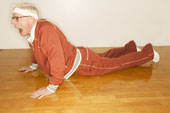
Is this a new concept to you? I mean, do you just randomly go from session to session without any real purpose? Or do you set it up where you try to beat your numbers from week to week? I’m curious to hear what you have to say, so let me know in the comments section below…
My Lower Body Session – 10/17/11
October 18, 2011 by danny · Leave a Comment
I’ve been splitting my training between my home gym and the gym at the local high school. Yesterday I headed down to the basement for my lower body (and “core”) session. Since I moved back to Illinois in late August I’ve been doing mostly “random workouts” due to the fact that I JUST added a squat rack and a few other pieces of “essential” equipment to my home gym. In the video you’ll see day 3 of week 2 in my current training block. I’m currently doing an upper/lower split and it feels good to back to a structured program again. Anyway, here’s what went down yesterday…
Today, I’m heading up to the high school to finish up week 2 of the 4 week program (upper body today – day 4).
Talk to you later in the week…
Aerobics For Basketball Players?
October 12, 2011 by danny · 2 Comments
Back when I was playing hoops in college, in the pre-season our team was tested in the 1-mile run. I didn’t think anything of it at the time, other than, coach wants to see how good of shape we are in, so I’m going to run this thing as fast as I can. Fast forward a number of years later, and I started to learn more about the body. I learned about different energy systems and which ones are used for particular tasks that we perform when competing in sports, or when working out in general. And as I become more educated, I remember thinking; I wonder why our coach tested us in the mile??? I mean, there is never a point in the game where we run 5 + minutes without a break. Hmm?
Anyway, I now know the mile to pretty much be a pointless test for basketball players. Basically, we sprint up and down the court, get in a defensive stance, chase our opponent around a few screens, box him out when the shot goes up, and sprint down to the other end of the court, run our opponents off a screen or two, and this continues for a bit. OR, a whistle is blown due to a foul, the ball goes out of bounds, a coach calls a T.O., a brawl breaks out in the stands (ahem, Detroit Pistons fans ![]() ), or something similar. Regardless, there is a break in the action very often. So again, none of this even comes close to resembling a 1-mile run.
), or something similar. Regardless, there is a break in the action very often. So again, none of this even comes close to resembling a 1-mile run.
I even touched upon the topic in this article that I wrote a few years back (towards the end of the article where I mention fast-twitch and slow-twitch muscle fibers). Strength Coach Charles Poliquin goes into a little further detail on the matter in his article, “Do Basketball Players Need Aerobics?”
With basketball season right around the corner (except for you NBA – come on, get it together!!!), coaches will be preparing their players with their conditioning program. Most basketball coaches know X’s and O’s, but are not qualified to run an “optimal” strength and conditioning program (understandably, as their time is spent recruiting, running camps, scouting, game planning, preparing for practice, etc etc.). Therefore, I’m hoping articles/blog posts like this will help steer these coaches in the right direction. So, if you are a basketball coach that’s about to start conditioning your players for the season, just remember, that basketball is a sport that is filled with a lot of starts and stops throughout the game.
Testing your athletes or simply conditioning your players with the mile run (or further) is NOT the way to go.
Feel free to forward this on to any b-ball coaches that you know. And don’t forget to check out Coach Poliquin’s article for more information on the topic.
Happy training!

